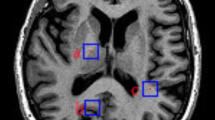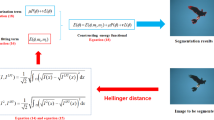Abstract
The segmentation of intensity inhomogeneity images is always a challenging problem. There are two kinds of intensity inhomogeneities, one associated with the imaging devices and illumination variations, and the other associated with the essential characteristics of the intensities in objects and backgrounds. We name the second kind of intensity inhomogeneity as intensity complexity. In this paper, we focus on the segmentation of the images with intensity complexity. Our main argument is to quantify the complex intensities and convert them into useful features to improve segmentation accuracy. Two new quantities called the region intensity complexity index (RIC-Index) and factor (RIC-Factor) are introduced to quantify the intensity complexity. Then the quantified intensity complexity is incorporated into a variational level set framework. The total energy functional of the proposed framework consists of the following three items: a region intensity complexity term, a local region fitting energy term, and an edge-based energy term. The first term is defined by exploiting the region intensity complexity factor of the images. Mean and variance are utilized in the local region fitting energy to describe the image texture information. The last term of the energy functional, which is also derived from the region intensity complexity factor, incorporates the significant edge information. By integrating these three terms, the proposed model can handle intensity complexity images, especially two kinds of images: one with complex intensities in the objects, and the other with complex intensities in the backgrounds. The experimental results on 40 intensity complexity images and 1000 natural images from the Extended Complex Scene Saliency Dataset have indicated that our proposed algorithm can produce satisfactory segmentation results in comparison with five state-of-the-art methods and a deep learning approach.
Access this article
We’re sorry, something doesn't seem to be working properly.
Please try refreshing the page. If that doesn't work, please contact support so we can address the problem.
















Similar content being viewed by others
Explore related subjects
Discover the latest articles, news and stories from top researchers in related subjects.References
Brox, T., Rousson, M., Deriche, R., & Weickert, J. (2010). Colour, texture, and motion in level set based segmentation and tracking. Image and Vision Computing, 28, 376–390.
Caselles, V., Kimmel, R., & Sapiro, G. (1991). Geodesic active contours. International Journal of Computer Vision, 22, 61–79.
Chan, T., & Vese, L. (2001). Active contours without edges. IEEE Transactions on Image Processing, 10, 266–277.
Courant, R., Friedrichs, K., & Lewy, H. (1967). On the partial difference equations of mathematical physics. IBM Journal of Research and Development, 11, 215–234.
Cremers, D., Rousson, M., & Deriche, R. (2007). A review of statistical approaches to level set segmentation: Integrating color, texture, motion and shape. International Journal of Computer Vision, 72(2), 195–215.
Dai, L., Ding, J., & Yang, J. (2015). Inhomogeneity-embedded active contour for natural image segmentation. Pattern Recognition, 48, 2513–2529.
Ge, Q., Li, C., Shao, W., et al. (2015). A hybrid active contour model with structured feature for image segmentation. Signal Processing, 108, 147–158.
Kass, M., Witkin, A., & Terzopoulos, D. (1988). Snake: Active contour models. International Journal of Computer Vision, 1, 321–331.
Kim, W., & Kim, C. (2013). Active contours driven by the salient edge energy model. IEEE Transactions on Image Processing, 22, 1667–1673.
Krizhevsky, A., Sutskever, I., & Hinton, G. E. (2012). Imagenet classification with deep convolutional neural networks. In NIPS (pp. 1097–1105).
Lankton, S., & Tannenbaum, A. (2008). Localizing region based active contours. IEEE Transactions on Image Processing, 17, 2029–2039.
Li, C., Kao, C., Gore, J., & Ding, Z. (2007). Implicite active contours driven by local binary fitting energy. In Proceedings of IEEE conference of computer vision pattern recognition (pp. 1–7). Minneapolis.
Li, C., Huang, R., Ding, Z., Gatenby, C., Metaxas, D. N., & Gore, J. C. (2011). A level set method for image segmentation in the presence of intensity inhomogeneities with application to MRI. IEEE Transactions on Image Processing, 20(7), 2007–2016.
Li, C., Kao, C., Gore, J., & Ding, Z. (2008). Minimization of region-scalable fitting energy for image segmentation. IEEE Transactions on Image Processing, 17, 1940–1949.
Liu, T., Sun, J., Zheng, N., Tang, X., & Shum, H. Y. (2007). Learning to detect a salient object. In Proceedings of IEEE international conference on computer vision pattern recognition (pp. 1–8).
Li, C., Xu, C., Gui, C., & Fox, M. D. (2010). Distance regularized level set evolution and its application to image segmentation. IEEE Transactions on Image Processing, 19, 3243–3254.
Long, J., Shelhamer, E., & Darrell, T. (2015). Fully convolutional networks for semantic segmentation. In Proceedings of the IEEE conference on computer vision and pattern recognition (pp. 3431–3440).
Mumford, D., & Shah, J. (1989). Optimal approximations of piecewise smooth functions and associated variational problems. Communications on Pure and Applied Mathematics, 42, 577–685.
Osher, S., & Sethian, J. A. (1998). Fronts propagating with curvature-dependent speed: algorithms based on Hamilton–Jacobi formulations. Journal of Computational Physics, 79, 12–49.
Perona, P., & Malik, J. (1990). Scale-space and edge detection using anisotropic diffusion. IEEE Transactions on Pattern Analysis and Machine Intelligence, 12(7), 629–639.
Ronneberger, O., Fischer, P., & Brox, T. (2015). U-net: Convolutional networks for biomedical image segmentation. In International conference on medical image computing and computer-assisted intervention. Springer, Cham (pp. 234–241).
Shi, J., Yang, Q., Li, X., et al. (2016). Hierarchical image saliency detection on extended CSSD. IEEE Transactions on Pattern Analysis & Machine Intelligence, 38(4), 717–729.
Szegedy, C., Liu, W., Jia, Y., Sermanet, P., Reed, C., Anguelov, D., et al. (2015). Going deeper with convolutions. In IEEE Conference on computer vision and pattern recognition (pp. 1–9). Boston.
Wang, L., Chang, Y., Wang, H., et al. (2017). An active contour model based on local fitted images for image segmentation. Information Sciences, 418–419, 61–73.
Wang, X. F., Huang, D. S., & Xu, H. (2010). An efficient local Chan–Vese model for image segmentation. Pattern Recognition, 43, 603–618.
Xu, C., & Prince, J. L. (1998). Snakes, shapes, and gradient vector flow. IEEE Tranactions on Image Processing, 7, 359–369.
Yan, Q., Xu, L., Shi, J., & Jia, J. (2013). Hierarchical saliency detection. In The IEEE conference on computer vision and pattern recognition (CVPR) (pp. 1155–1162).
Zhang, K., Song, H., & Zhang, L. (2010). Active contours driven by local image fitting energy. Pattern Recognition, 43, 1199–1206.
Zhang, K., Zhang, L., Lam, K. M., & Zhang, D. (2016). A level set approach to image segmentation with intensity inhomogeneity. IEEE Transactions on Cybernetics, 46, 546–557.
Zhao, G., Qin, S., & Wang, D. (2018). Interactive segmentation of texture image based on active contour model with local inverse difference moment feature. Multimedia Tools and Applications, 77(18), 24537-C24564.
Zhi, X. H., & Shen, H. B. (2018). Saliency driven region-edge-based top down level set evolution reveals the asynchronous focus in image segmentation. Pattern Recognition, 80, 241–255.
Acknowledgements
This work is supported by National Nature Science Foundation of China (Nos. 11531005, 11971229) and Science Foundation of Zhejiang Sci-Tech University (ZSTU) (No. 19062406-Y).
Author information
Authors and Affiliations
Corresponding author
Additional information
Publisher's Note
Springer Nature remains neutral with regard to jurisdictional claims in published maps and institutional affiliations.
Rights and permissions
About this article
Cite this article
Li, X., Liu, H. & Yang, X. Region intensity complexity active contours. Multidim Syst Sign Process 31, 1185–1206 (2020). https://doi.org/10.1007/s11045-020-00704-5
Received:
Revised:
Accepted:
Published:
Issue Date:
DOI: https://doi.org/10.1007/s11045-020-00704-5




